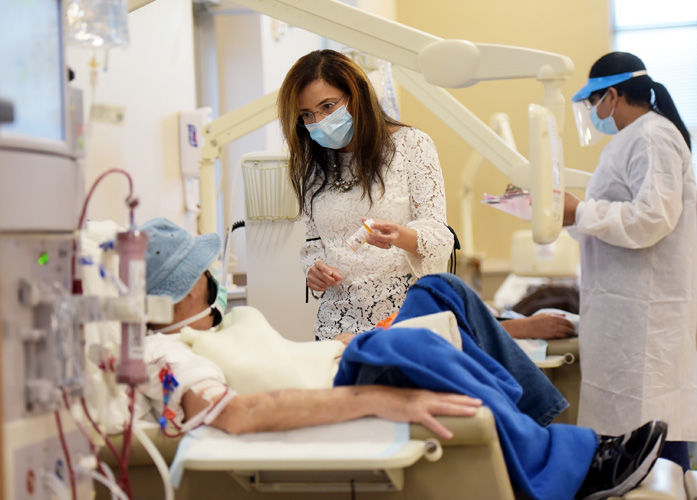Dialysis clinics, already keenly aware of the dangers of infection, have ramped up precautions after at least two patients receiving the life-giving treatments in Indian River County have been found positive for COVID-19.
Both patients were in scenarios considered higher risk for catching the disease.
One was a resident in a long-term care facility; the other was someone who travelled back and forth out of state, according to Dr. Saatiah Jaffry, a Sebastian kidney specialist who owns Sebastian Dialysis Care Clinic. The two patients were not part of her practice, and she was not authorized to provide further details.
Jaffry said she did not think there were “many more” dialysis patients with the disease here at the moment, but that in neighboring counties, COVID-19 has been hitting highly vulnerable dialysis patients in greater numbers. One of her patients in Brevard County, who had resumed dialysis treatments after traveling internationally, died after testing positive for COVID-19.
That loss, along with the latest news of COVID-19 appearing among Indian River County dialysis patients – even in small numbers – is of deep concern to Jaffry. But the apparent success of the Brevard dialysis center in preventing further infection gives her hope of containment, and she was anxious to reassure patients for whom ongoing dialysis is a lifesaving measure that clinics nationwide have plans aimed at keeping them safe during COVID-19.
“When this first started, maybe even more than the government, the dialysis companies took this threat seriously. They knew this could spread very easily at dialysis centers and that our patients were at extremely high risk of getting very sick and dying from this condition,” she said.
Precautions include plans within each dialysis clinic system to isolate COVID-positive patients. If there are multiple facilities in one area, and a substantial number of infected patients, a single clinic might be designated for all COVID-19 patients as a means to prevent spread and preserve personal protective equipment like masks, gloves, gowns and shoe covering.
Other clinics may create separate treatment spaces or isolation rooms or may schedule those patients at the end of the day, “most likely the third shift after all the other patients leave,” said Jaffry.
Even before the pandemic, infection control was ingrained in her staff, Jaffry says.
“Dialysis patients are sick and in and out of the hospital,” said Jaffry. “Between patients, they Lysol-wipe the chairs because there’s MRSA and other infections. As it is, staff members take sterile precautions because they’re dealing with blood. They wear masks anyway and wear gloves anyway. But now with COVID-19, they’re being extra careful.”
Jaffry’s clinic manager has been getting as much PPE as possible each week, although the vendors “only have so much.”
If there are patients of Jaffry’s clinic who turn up positive for COVID-19, they could enter through a separate emergency exit that bypasses the lobby. “Only the staff that is absolutely needed to take care of the patient – one nurse and one technician – would be there. Everybody else would leave,” Jaffry said.
Once the patient has left, those two caregivers would take off their PPE. Jaffry says some might bring an overnight bag with a change of clothes and take a shower before they leave for home.
When everyone is gone, a special crew would come in to clean.
“You can also spread the patients out on the schedule so there is not a COVID-19 patient there at the same time as non-COVID-19 patients.”
The dialysis treatments, which typically last four hours and are done three times a week, involve close contact between caregiver and patient. The room typically has multiple patients undergoing the procedure in the same shift, 16 in the case of Jaffry’s clinic, plus one isolation room – originally intended not for COVID-19 patients, but for those with hepatitis-B.
Shifts start as early as 5 a.m. “Some people have to go to work,” she said.
Patients are fitted with a catheter in the neck or a fistula or graft in the arm. From those access points, soft tubing draws blood into the dialysis machine, where it is cleaned of salt, waste and extra water. Potassium, sodium and other chemicals in the body are adjusted at the same time.
Some dialysis is only temporary, used while the body is in acute kidney failure, and stopped once the kidneys heal.
Most often, though, dialysis is a last-resort measure in late-stage disease when a kidney transplant is not available or not an option. By then, patients are often ill with multiple diseases – hypertension, diabetes, congestive heart failure – any one of which would make them more vulnerable to COVID-19. Those on dialysis are at high risk of having a severe case of COVID-19 if they contract the novel coronavirus.
Florida is ranked 13th in the nation for numbers of patients with chronic kidney disease, with around 25,000 people affected. In the half-dozen dialysis clinics in Indian River County, around 250 patients are getting treatments, Jaffry estimates.
Her own clinic is part of the American Renal Associates (ARA), a chain of 244 dialysis centers. Another clinic, Renal Care Center, is owned by Fresenius, a chain with 4,000 centers nationwide. The other local dialysis centers are owned by DaVita, a 2,700-clinic chain. Jaffrey cares for patients at both the ARA clinic, which she opened for ARA in 2018, and at DaVita.
Should COVID-19 numbers surge in Indian River County, there would likely be increased need for dialysis machines, as COVID-19 often causes kidney failure in patients sick enough to need hospitalization. Those machines are provided at the hospitals.
Now, as Florida begins to reopen after its semi-shutdown, the risks to dialysis patients increase. Jaffry worries that a COVID-19 surge could frighten them into forgoing their dialysis. “Our patients need to keep coming in,” she said.

